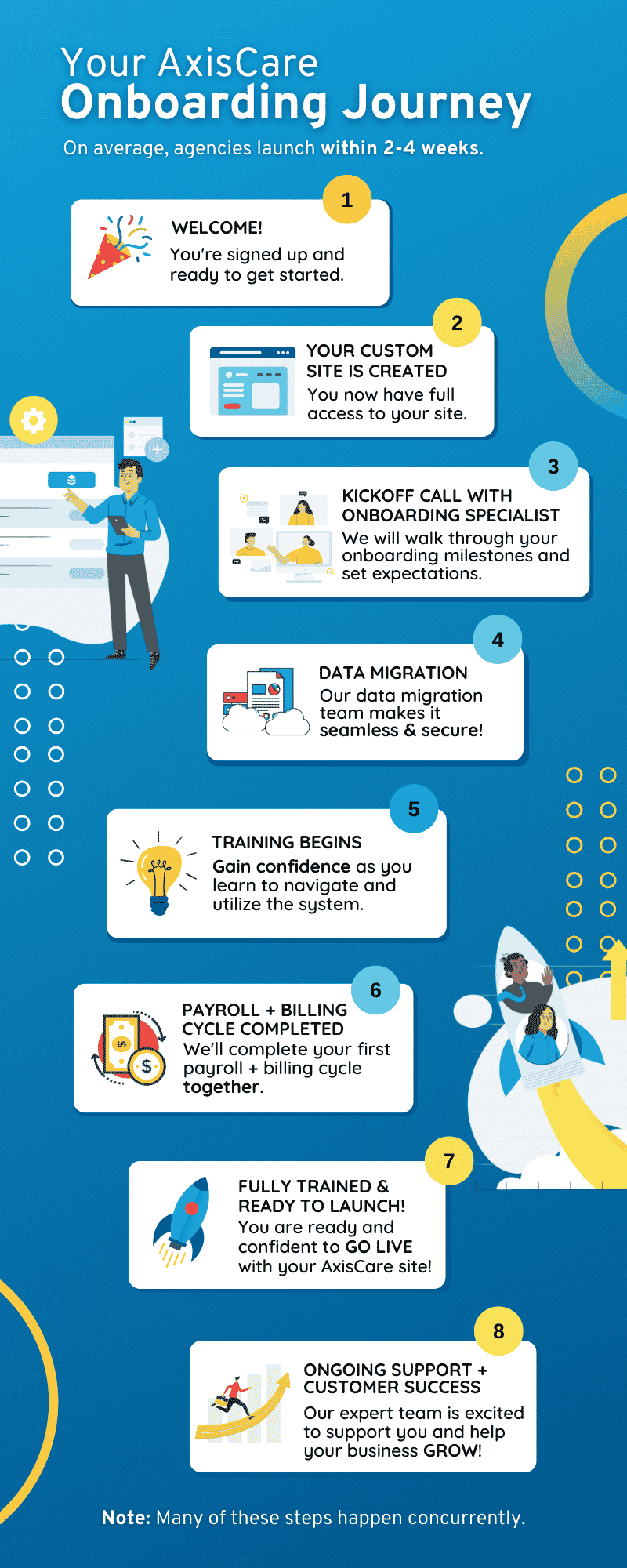Retaining caregivers has been highlighted as a particular issue in the home care industry, with 46% of surveyed agencies in a recent third-party survey stating they experienced challenges in retaining staff. This industry wide hurdle is multi-faceted, stemming from various factors including burnout, lack of adequate compensation, and insufficient recognition. The demand for qualified candidates is just beginning, In fact, industry professionals project that an extra 7.8 million caregivers will be needed by 2026. That’s a 76% increase compared to 2014. Here are a few proven methods to retain your caregivers, ensuring a stable and compassionate workforce for those in need of care.
Ongoing Caregiver Retention Challenges
It comes with no surprise that high turnover rates in the home care industry often stem from the intense emotional and physical demands placed on caregivers, making the role challenging to sustain long-term, especially with adequate support from their employer. Let’s look under the hood into the root cause of these caregiver retention struggles.
Rising Wages in Competing Sectors
With wages in many other fields rising at a faster pace, caregivers often feel underpaid and underappreciated. This wage gap can foster a sense of financial instability and lack of recognition, prompting even the most dedicated caregivers to look for better-paying and more lucrative opportunities elsewhere. Home care agency owners should reassess wage structures and offers competitive compensation to attract and retain skilled caregivers, ensuring that these professionals feel both valued and financially secure in their roles.
Caregiver Burnout
Overworking, poor scheduling, and heavy workloads can all cause caregivers to burnout. When caregivers are consistently given excessive hours without adequate rest, they are more prone to physical exhaustion and emotional fatigue. Furthermore, inconsistent or unpredictable schedules disrupt their work-life balance, making it challenging to maintain personal commitments and overall well-being. This and more contribute to higher stress levels and a greater likelihood of burnout among caregivers.
Lack of Quality Shifts/Lack of Consistent Shifts
Poor scheduling can lead to inconsistent shifts, forcing caregivers to navigate erratic work hours that disrupt their personal lives and work-life balances. Not to mention, long commutes between visits not only heighten stress levels but can also detract from the quality of care provided, leaving both caregivers and clients dissatisfied.
1. Offer Competitive Compensation & Benefits
By incorporating items such as overtime pay competitive wages, and a benefits package, it acknowledges the extra effort caregivers often put into their roles, ensuring they are fairly compensated and recognized. Paid time off (PTO) is equally important, allowing caregivers the necessary rest and recuperation they need to perform their duties effectively without facing burnout. Offering PTO ensures that caregivers can maintain a healthy work-life balance, which is essential for their overall well-being. When caregivers feel supported through competitive wages and comprehensive benefits, they are more likely to remain committed to their roles, delivering high-quality care and contributing to a more stable and compassionate workforce.
2. Provide Development Opportunities for Caregivers
Supporting your caregivers’ career growth by offering development opportunities from your agency is crucial. Comprehensive training programs can equip caregivers with essential skills, enhancing their competencies, personal resumes, and further elevating the quality of care they provide. Offering certification opportunities not only validates their expertise but also empowers them with a sense of achievement and professional recognition. Furthermore, establishing clear pathways for advancement can drive long-term career satisfaction, giving caregivers a tangible goal to strive towards.
3. Create a Positive Work Environment
Creating an inclusive and supportive environment for your caregivers can have a massive impact on your staff satisfaction. Implementing easy-to-use communication channels ensures that caregivers feel heard and understood, fostering a sense of belonging and trust within the organization. Recognition programs that celebrate caregivers’ efforts and achievements can significantly boost morale, making them feel appreciated for their hard work and dedication. Additionally, opening a dialogue for regular feedback and acknowledging their contributions can reinforce their importance within the team.
4. Recognition of Good Performance
Consider implementing a incentivizing and rewarding those who have done outstanding work – fostering a culture of appreciation and motivation. This can include incentives such as monetary rewards, performance-based bonuses, and formal company recognition, which further encourage caregivers to excel in their roles. By celebrating their achievements and highlighting their dedication, caregivers are more likely to feel valued and appreciated.
5. Emphasize a Work-Life Balance
Respecting your caregivers’ limitations and providing a healthy workload is paramount for their long-term well-being and job satisfaction. By incorporating flexible scheduling, you can significantly increase loyalty and prevent burnout among staff. This approach allows caregivers to manage their personal and professional responsibilities more effectively, fostering a better work-life balance. Understanding and accommodating the unique needs of each caregiver can lead to a more motivated and resilient workforce ready to serve those in need.
6. Better Communication With Caregivers
Regular check-ins with caregivers provide invaluable insights into their satisfaction, performance and well-being, highlighting areas where they may need additional support or resources. Transparent and open communication allows you to make timely adjustments to schedules and workloads, ensuring a balanced distribution of responsibilities. This proactive approach not only addresses potential issues before they escalate but also demonstrates that you value and respect the contributions of your caregiving staff.
7. Improved Recruitment Procedures
By putting a larger emphasis on recruiting qualified candidates through a more rigorous interview process, you can get a better understanding of a caregiver’s strengths and weaknesses. This allows you to assess candidates not only on their technical skills but also on their alignment with your agency’s values. As a result, you can make more informed hiring decisions that are tailored to meet specialized needs, such as providing care for clients with specific conditions such as Alzheimer’s or unique personal preferences. Ultimately, this ensures that the selected caregivers are well-equipped and genuinely suited for their roles, enhancing the overall quality of care provided.
Streamline & Improve Your Retention Process With AxisCare
By investing in the well-being and professional growth of your caregivers, you create a stable, motivated, and compassionate workforce dedicated to providing high-quality care. Implementing comprehensive benefits, offering development opportunities, and fostering an inclusive environment are key strategies to enhance caregiver job satisfaction and reduce turnover. When caregivers feel valued and supported, they are more likely to remain committed to their roles and deliver the exceptional care your clients deserve.
With AxisCare, you can effortlessly implement best practices, monitor caregiver satisfaction, and provide the support they need to thrive, book a demo to learn more.









